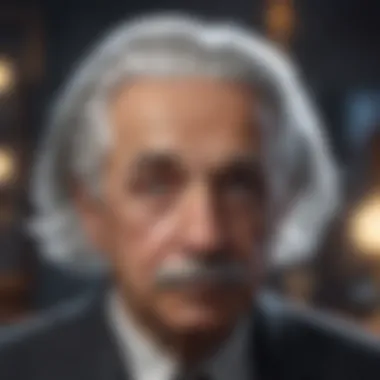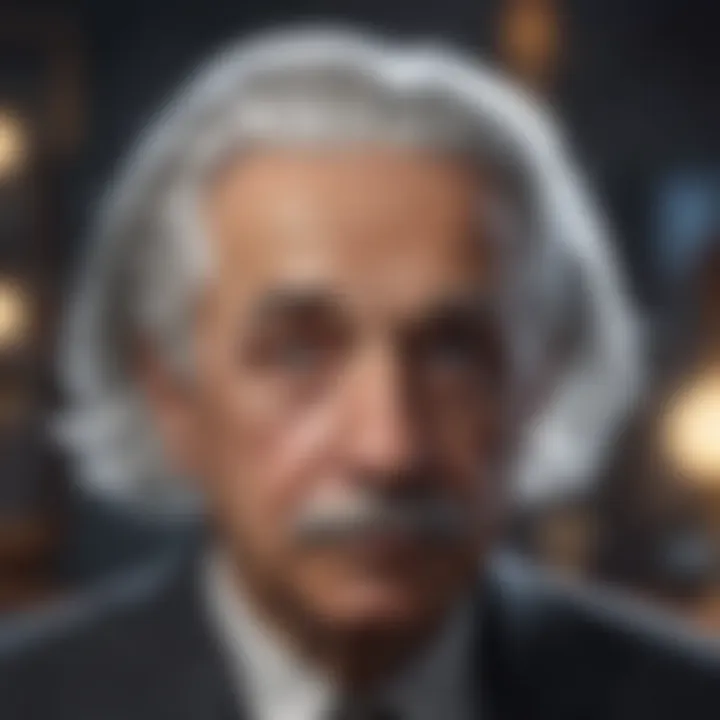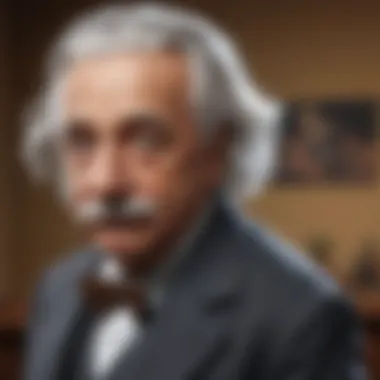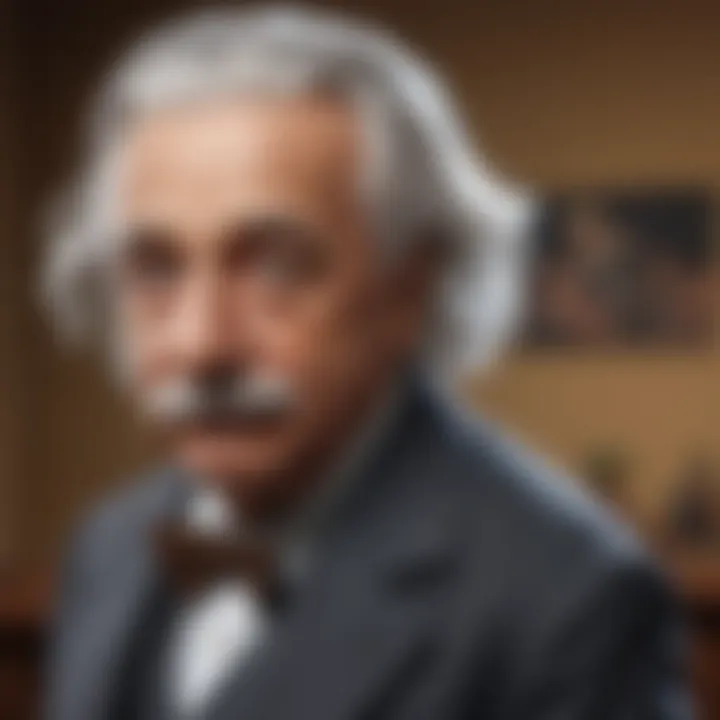Einstein and Isaacson: The Legacy of Science and Story


Intro
The intersections between science and narrative are often intricate and profound. Albert Einstein, one of history's most celebrated physicists, gave us theories that not only transformed our understanding of the universe but also sparked curiosity and debate that persists to this day. Walter Isaacson, a master biographer, has breathed life into Einstein's story, painting vivid portraits of both his scientific endeavors and personal life. Their contributions can be examined together to reveal a greater understanding of how scientific ideas are communicated and cherished across generations.
Through this exploration, we aim to unravel the threads that connect Einstein’s innovative concepts to Isaacson's articulate writings. It is essential to look at how these narratives shape public perception and appreciation for science, providing depth to what could otherwise seem like abstract theories. By navigating through their respective contributions, we can afford ourselves greater insight not only into Einstein's legacy but also into the art of biography.
Book Categories
Science and Biography
When considering the realms of literature in which Einstein and Isaacson operate, one cannot ignore the synergy between science and biography. Walter Isaacson emphasizes not just Einstein's scientific theories but also his personal struggles, philosophical views, and the socio-political landscape of his time. Such narratives are crucial as they integrate the human aspect within the often rigid structure of scientific discussion.
Non-Fiction
Isaacson's works primarily belong to non-fiction, categorizing them as a source of fact and knowledge. For readers seeking to understand complex ideas in a digestible format, his writings stand out. Rather than drowning readers in jargon, he translates Einstein's intricate thoughts into prose that resonates with the layperson while maintaining scholarly integrity. Notably, his book Einstein: His Life and Universe encapsulates this approach effectively.
The Essence of Connection
The heart of this article lies in the interwoven nature of Einstein's theories and Isaacson's interpretations. Together, they shed light on significant themes that echo through both the scientific community and general society. Understanding this interrelationship compels us to consider key areas:
- Scientific achievements: This area encompasses the breakthroughs that position Einstein as a cornerstone of modern physics.
- Personal philosophy: A look into how his beliefs shaped and were shaped by his scientific work and personal experiences.
- Socio-historical context: The backdrop against which Einstein developed his theories, providing necessary insight into the dynamics of his time.
Key Insights and Takeaways
A careful exploration of Einstein's legacy as portrayed through Isaacson's writing reveals several nuggets of wisdom:
- Innovation requires persistence: Einstein's groundbreaking discoveries were not born in a vacuum. His tireless dedication continues to inspire new generations of thinkers.
- Science is a human story: Every theory has a backstory, entwined with the personal experiences, societal pressures, and moral dilemmas faced by its creator.
- Life shapes science: The application of Einstein's theories such as relativity emerged not only from intellect but also the socio-historical context surrounding him, as narrated by Isaacson.
"Books are the quietest and most constant friends; they are the most accessible and wisest counselors." – Charles W. Eliot
Applying Lessons from Einstein and Isaacson
As we sift through their narratives, the lessons gleaned can be applied in various domains:
- Cross-disciplinary exploration: Embrace the intersectionality of knowledge and be open to insights from other fields, as science often reflects broader human experiences.
- Emphasizing storytelling in science: For educators, weaving personal stories into scientific presentations can make complex ideas relatable and memorable.
- Encouraging curiosity: Remaining question-oriented and always seeking answers fosters a culture of innovation and progress.
The connection between Einstein's scientific contributions and Isaacson's biographical storytelling enriches the understanding of both figures. As we dive deeper into their interactions, we unravel an ongoing dialogue about knowledge, legacy, and what it means to bond with the world of ideas.
Prelims to Einstein and Isaacson
The intertwining tales of Albert Einstein and Walter Isaacson represent a significant exploration of human intellect and creativity. When we delve into their contributions, we find not only revolutionary physics but also compelling narratives that frame these scientific breakthroughs within a broader cultural and historical landscape. Understanding this relationship sheds light on how ideas propagate across generations, affecting the collective consciousness of society.
In recent years, Einstein’s theories, from the theory of relativity to quantum mechanics, have not just remained preserved in the annals of physics but have become a cornerstone in discussions encompassing philosophy, ethics, and even politics. It's interesting how a figure who lived over a century ago can still ignite discussions about technological advancements and moral responsibilities in today's world.
On the other hand, Walter Isaacson’s approach to biography is especially relevant in connecting Einstein’s complex life with his scientific pursuits. By employing vivid storytelling, Isaacson brings the cold equations of physics into touch with the warmth of human experience. He interlaces personal anecdotes with scientific principles, giving readers an inside view of how Einstein's mind operated and what inspired his profound insights.
This article aims to map out these dynamics, illustrating not just the contributions of Einstein, but also how Isaacson’s framework enriches our understanding. By examining their relevance and interplay, we can appreciate how narratives shape our understanding of science and its pioneers.
The Relevance of Einstein Today
In our modern world, Einstein's contributions remain alarmingly pertinent. Take, for instance, his insights into the fabric of spacetime—concepts that have sparked innovations in fields like satellite technology and GPS navigation. As we rely on these technologies daily, we might not realize that we owe part of this functionality to Einstein’s theories, demonstrating the timelessness of his ideas.
Moreover, Einstein's views on social issues and humanity resonate increasingly in contemporary discussions. His stance on pacifism and empathy introduced a dimension to science that extends beyond laboratory confines, reminding us that scientific duty is not isolated from societal impact. It invites a broader dialogue on ethics in technology, an essential conversation in an age where AI and genetic engineering pose pressing moral dilemmas.
Isaacson's Perspective on Einstein
Walter Isaacson's biography of Einstein offers a fresh lens through which to explore the physicist's life and achievements. Rather than mere facts and figures, Isaacson captures the essense of Einstein as a person—his passions, struggles, and the nuances that shaped his revolutionary thinking. He humanizes the genius often perceived as aloof, revealing a man who loved nature, music, and the curious engagement of youth.
Isaacson meticulously weaves Einstein’s scientific milestones with historical context, allowing readers to grasp how external events influenced his thought processes. For instance, the impact of world wars and societal shifts on his theories cannot be overstated. By presenting this fuller picture, Isaacson enables a deeper appreciation of Einstein’s work beyond academic circles, showcasing its relevance to political, ethical, and everyday discussions.
In summary, as we explore the themes and narratives that connect Einstein and Isaacson, we grasp not only their respective brilliance but also the valuable lessons their lives convey. The interplay between genius and biography paints a richer tapestry of understanding, making it all the more essential in today’s fast-paced world.


Einstein's Major Contributions to Physics
Einstein’s impact on the field of physics is nothing short of revolutionary. His theories have not only altered the course of scientific inquiry but have also influenced various aspects of culture, philosophy, and even technology. Understanding Einstein's major contributions is crucial, as it leads to a deeper appreciation of how science evolves and interweaves with the broader narrative of humanity.
The Theory of Relativity
When discussing Einstein, the Theory of Relativity is undoubtedly at the forefront. This theory consists mainly of two parts: special relativity and general relativity, both of which dismantled the long-standing Newtonian physics that ruled before them.
Special relativity, introduced in 1905, fundamentally changed how we perceive space and time. One of its core principles is that the laws of physics remain consistent for all observers, irrespective of their relative motion. This radical idea implies that time is not a constant, as previously thought; rather, it can vary for different observers based on velocity. The famous equation E=mc² stems from this theory, intertwining mass and energy in a phenomenal way. This insight has ramifications beyond physics, touching on philosophy and how we conceptualize existence itself.
"The distinction between past, present, and future is only a stubbornly persistent illusion." – Albert Einstein
The second part, general relativity, published in 1915, expanded these notions into a theory of gravitation, revolutionizing our understanding of spacetime. Previously, gravity was viewed in a relatively simple manner. Einstein posited that massive objects warp the fabric of spacetime, creating what we perceive as gravitational attraction. This can be seen in everything from the orbit of planets to the path of light around massive celestial bodies.
This concept not only reshaped astrophysics but has also been critical in understanding phenomena such as black holes and gravitational waves—ideas that are foundational in modern cosmology.
Quantum Mechanics and Its Implications
While Einstein is often viewed as a champion of relativity, he had significant reservations about quantum mechanics. Nevertheless, his contributions to this field were pivotal. His explanation of the photoelectric effect, for which he won the Nobel Prize in Physics in 1921, was a cornerstone in establishing quantum theory. He suggested that light can behave like both a wave and a particle, leading to the concept of photons, thereby laying the groundwork for quantum mechanics.
This duality pushed scientists to rethink the nature of reality itself. It's not merely the properties of matter that are perplexing. The fundamental idea that observation affects phenomena has provoked heated debates and inspired extensive philosophical discourse, often leading to contrasting interpretations, such as the Copenhagen interpretation and many-worlds hypothesis.
The implications of quantum mechanics are vast, influencing not only theoretical physics but also practical fields—quantum computing and cryptography are just two areas that owe their existence to these principles.
In summary, Einstein's contributions to physics are paramount, shaping the very framework within which modern science operates. His works demonstrate how theory and practice can diverge and yet still connect threads in ways that enlighten human thought and understanding. The future of science, tangled as it is with his ideas, continues to challenge our grasp of the universe.
Biographical Insights from Isaacson
Walter Isaacson’s biographical narratives shed light on not just the scientific accomplishments of Albert Einstein but also the complexities of his character and the world he inhabited. Isaacson's ability to weave an engaging tale from the threads of Einstein’s life offers readers a nuanced understanding of what shaped the mind behind revolutionary theories. This exploration is crucial not only for appreciating Einstein’s scientific contributions but for grasping how personal, cultural, and historical contexts interplayed to define a genius.
Isaacson does not merely present facts and figures; instead, he paints a portrait that highlights the interplay between Einstein’s intuition and rational thought. His narrative provides multiple lenses through which to view Einstein's life, revealing not only the triumphs but also the challenges and contradictions that defined him. The dichotomy of Einstein as a brilliant physicist and a passionate advocate for social justice illustrates how deeply personal convictions can coexist with scientific endeavors. Through Isaacson’s lens, we gain insights into the mind of a man often idolized but rarely understood in his entirety.
Narrative Style and Structure
Isaacson’s approach to narrative is both biographical and richly contextual, often resembling a novel more than a traditional biography. He utilizes a methodical structure, blending chronological storytelling with thematic explorations. This allows the reader to contextualize Einstein’s achievements within the cultural and scientific milieu of his time. The use of vivid anecdotes brings to life the characters that surrounded Einstein, ranging from fellow scientists to personal acquaintances.
For instance, when discussing Einstein's time in Berlin, Isaacson captures the tensions of the era, not just in the sphere of physics but also in societal interactions. This narrative style makes the science accessible, allowing readers to appreciate the weight of Einstein’s ideas while being captivated by the granular details of his life.
Key Themes in Isaacson's Works
The themes present in Isaacson's biographies are as varied as they are profound. Key themes include:
- The evolution of ideas: How scientific theories develop over time and through collaboration. Isaacson highlights the collective effort behind scientific breakthroughs, showcasing the interplay of diverse thinkers in Einstein's revolutionary insights.
- The humanization of genius: By illustrating Einstein’s personal struggles, relationships, and societal commitments, Isaacson reminds readers that even the greatest minds grapple with insecurity and doubt.
- The impact of historical context: Each chapter reflects the environment that influenced Einstein's thinking, whether it be the ramifications of World War I, the rise of anti-Semitism, or the scientific community’s reaction to his theories.
- Ethical considerations in science: Isaacson discusses how Einstein's values and sense of social responsibility informed his scientific work and public stance on issues such as war and peace, which aligns with the broader themes of morality in science.
"Biographies are more than the story of an individual's life; they reveal the era's soul and what people fought for—ideas that can change the world."
Isaacson’s biographical insights deliver a richer understanding of Einstein and offer a template for engaging with other figures in science. By crafting a narrative that intertwines personal, scientific, and historical specifics, Isaacson not only informs but also inspires future generations to appreciate the legacies of great minds.
Interplay Between Science and Biography
The relationship between science and biography is vital in understanding themes that shape our perceptions of scientific endeavors. In the case of Albert Einstein and Walter Isaacson, this interplay enriches our grasp of not only Einstein's scientific work but also the personal experiences that informed his ideas. Science is not conducted in a vacuum; it’s a dance of intellect intertwined with the varied human experiences that scientists undergo.
When engaging with biographies of renowned figures like Einstein, we glean insights into the psychological and emotional layers that underpin their groundbreaking work. It is here that the reader meets the scientist not just as a portrait of genius, but as a complex human being facing struggles, societal changes, and personal dilemmas.
Moreover, the impact of biography often serves to humanize these towering figures. Through Isaacson's writing, readers learn how personal relationships, historical contexts, and even cultural shifts shaped Einstein’s theories. By situating scientific advancements within the tapestry of a scientist’s life, we foster a deeper appreciation of the intrinsic motivations behind revolutionary ideas.
In short, biographies serve as mirrors reflecting the intricate connections between a scientist's life and their work, facilitating a richer understanding of the scientific contributions at play.
The Human Element in Science
Science has often been perceived as a cold, rational endeavor, divorced from the emotional and subjective experiences of those who practice it. However, this view dismisses the profound importance of the human element. Einstein, as presented by Isaacson, is not merely a name in a textbook; he is portrayed as a passionate individual wrestling with ethics, faith, and the weight of his revolutionary thoughts.


Understanding the human side of Einstein is crucial for grasping the significance of his contributions. For example:
- Struggles with Acceptance: Einstein's theories were not readily embraced. His journey through skepticism and critique highlights the persistence of an individual against a backdrop of rigid scientific norms.
- Personal Relationships: Insights into Einstein's relationships with colleagues, family, and friends reveal how these dynamics influenced his scientific thinking. Rather than appearing as a solitary genius, he is shown to be part of a community, actively engaging with the ideas of others.
- Cultural and Political Context: The world events that unfolded during Einstein's life, including the two World Wars, shaped his views on science and humanity. These historical elements are pivotal for understanding his stance on issues like nuclear power and pacifism.
Through Isaacson’s narrative style, readers can appreciate how these human stories contribute significantly to the broader understanding of Einstein as a scientist.
How Biographies Influence Public Perception
Biographies play a monumental role in shaping public perception of scientific figures. They can elevate a scientist from obscurity to celebrity and often influence the societal understanding of scientific concepts. Walter Isaacson’s portrayal of Einstein offers a lens through which we examine several aspects of this phenomenon.
- Framing Ideas: Biographies have the power to frame how we perceive a scientist's ideas. Isaacson’s presentations of Einstein's theories demystify complex topics, making them accessible to the general public. By contextualizing scientific contributions within Einstein's life, readers can relate to these novel ideas on a personal level.
- Cultivating Legacy: Isaacson's works solidify Einstein's legacy in the public eye. Through vivid storytelling, he crafts a narrative that imbues Einstein with traits of heroism and moral responsibility, qualities that resonate with readers and shape their perceptions of scientific integrity.
- Encouraging Dialogue: By humanizing Einstein and exploring his struggles, biographies invite engagement and discussion around the ethical dimensions of science. The public begins to recognize that scientific inquiry is not devoid of moral considerations, further nudging the collective conversation in new directions.
Socio-Historical Context of Einstein's Work
Understanding the socio-historical context of Einstein's contributions reveals how external factors influenced his revolutionary ideas. The early twentieth century was a period marked by rapid advancements in technology, warfare, and social change. This backdrop not only shaped the scientific inquiries of the time but also served as a framework for Einstein’s creativity and thought processes.
The Scientific Community of the Early Twentieth Century
In the early 1900s, the scientific community was bustling with activity. Physicists were grappling with the undermining of classical mechanics, particularly after the introduction of quantum theory. This era saw the rise of notable figures such as Max Planck, Niels Bohr, and Marie Curie, all of whom were pushing the boundaries of what was known. Einstein was right in the thick of this vibrant environment.
His 1905 paper on the photoelectric effect was both a response to and a catalyst for the ongoing discussions regarding light behavior. Rather than working in isolation, he thrived on the debates and challenges posed by his contemporaries. The scientific community played a critical role in Einstein's development, forcing him to refine and clarify his ideas. To wit, the back-and-forth of intellectual discourse provided fertile ground for innovations like the theory of relativity.
"Science can be only as profound as the social conditions of those who produce it."
— Walter Isaacson
The Impact of World Events on Scientific Discourse
World events profoundly influenced scientific discourse during Einstein’s career. The two World Wars shifted priorities and resources within the scientific community. Suddenly, many physicists found their work at the service of military endeavors. Einstein himself was a vocal opponent of atomic weapons, despite his technical involvement in the Manhattan Project through an ominous letter to President Franklin D. Roosevelt.
Moreover, these tumultuous times affected funding and policy-making in science. The interplay of war and peace shaped the motivations for scientific inquiry and the public's perception of science as a tool for progress or destruction.
Socio-historical factors did not only shape scientists’ lives. They influenced public perceptions of science. The rise of mass media during this period allowed figures like Einstein to become cultural icons, their ideas circulating far beyond academic circles. This blend of social and historical context with scientific breakthroughs contributed to a richer understanding of Einstein's legacy, showcasing how interconnected human experiences are with scientific pursuits.
In summary, the socio-historical landscape of Einstein's era was not merely a backdrop; it was intricately woven into the fabric of his scientific contributions. Understanding these elements helps to clarify the complexities surrounding his work and the legacies left by both him and Isaacson.
Legacy of Einstein in Contemporary Thought
The legacy of Albert Einstein extends far beyond the realm of physics; his influence shapes current scientific discourse, philosophical inquiry, and even cultural narratives. This legacy is not merely preserved in textbooks or academic symposiums; it permeates everyday life, prompting profound reflections on the nature of knowledge and understanding. In a world that is continuously evolving, Einstein's concepts remain pivotal not only in academic circles but also in the public consciousness.
Just consider how the theory of relativity reframes our understanding of time and space. To many, it's not just a scientific theory but a lens through which we can view our existence. The idea that time can bend and shift based on speed or gravitational pull adds layers of depth to our understanding of the universe and our place in it. Such insights challenge individuals to think critically about reality, pushing them to embrace complexities rather than cling to simple explanations.
Interpretations in Modern Physics
Einstein's contributions to modern physics continue to resonate powerfully in contemporary scientific discussions. His theories about relativity and the photoelectric effect paved pathways for advancements that redefine how we perceive time, energy, and the very fabric of reality. In recent years, concepts like quantum entanglement and the search for a unified field theory stand as testaments to the lasting effects of his groundbreaking ideas.
Among physicists, Einstein's work is often viewed not just as fundamental but also as a source of inspiration. For instance, theories related to the expanding universe and black holes—once thought impossible—now form the bedrock of cosmology and astrophysics. The famous equation E=mc² continues to be a fundamental principle that informs technologies such as nuclear energy and particle physics.
Moreover, the resurgence of interest in Einstein’s theories reinforces their relevance. As we delve into complexities like dark matter and dark energy, the foundational principles laid by Einstein guide researchers who aim to make sense of these intricate phenomena. This reflects a continual interaction between Einstein's theories and modern physics, showcasing how innovations can drive further exploration while revisiting established ideas.
Cultural References and Popular Media
Einstein's image has been cemented in popular culture, transcending the boundaries of science to become a global icon. His theories have not only influenced scientific thought but have also found their way into films, literature, and even artwork. The way he is depicted resonates—an eccentric genius with wild hair, an approachable figure whose ideas are both profound and accessible.
In film, productions such as "Einstein and Eddington" and the animated series "Futurama" bring Einstein's legacy into contemporary narratives, fostering interest in science among lay audiences. These representations often simplify complex ideas but also introduce key concepts of relativity and quantum physics to viewers who might otherwise never encounter them.
Additionally, Einstein’s influence stretches into graphic novels and documentaries, which further explore his life as both a scientist and an individual with lofty ideals. These cultural artifacts serve to humanize Einstein, making his groundbreaking theories seem less abstract and more relatable.
"Scientific understanding doesn't have to be confined to laboratories; it can be found in the stories we tell, the art we create, and the people we celebrate."
In this regard, popular media cultivates a space for dialogue about Einstein's work and its implications, encouraging a wider audience to engage with scientific principles. The ability of his legacy to inspire curiosity and discussions about science solidifies its place in contemporary thought.
As the interplay between physics and popular culture continues to evolve, one can only wonder how future generations will interpret Einstein's contributions. His work fosters contemplation of our universe, nudging the curious to dig deeper into their understanding of life, space, and existence.


Analyzing Isaacson's Broader Works
Walter Isaacson's work goes far beyond mere biographies; it's an exploration of the intricate dance between humanity and genius. In this article, highlighting Isaacson's broader works shines a light on how he weaves together the threads of science, art, and personal narratives. His biographies are not just lifelines of significant figures like Einstein but also serve as cultural commentaries that reflect on creativity and innovation.
The Intersection of Science and Biography
What sets Isaacson's narratives apart is his remarkable ability to merge the realms of science and biography. He effectively showcases how personal struggles and triumphs shape the scientific mind, and in doing so, he paints a fuller picture of his subjects. For ample examples:
- Historical Context: By placing individuals like Einstein in their socio-historical settings, Isaacson helps readers understand external factors influencing scientific discovery. For instance, the turmoil of World War I and II undoubtedly impacted Einstein's thought process, which Isaacson meticulously details.
- Psychological Insight: Isaacson does not shy away from the psychological aspects that underlie scientific genius. In his portrayal of Einstein, he addresses the personal struggles that the physicist faced, such as exile and family issues, illustrating how these aspects intertwined with his brilliant mind. This approach invites readers to empathize with the subject while simultaneously appreciating their monumental contributions to science.
Isaacson's unique storytelling brings to life the complexities of these historical figures; he excels in delineating not just their accomplishments but also the motivations behind them. It showcases that genius isn't an isolated phenomenon but rather a product of the individual in relation to the world around them.
Roles of Other Figures in Einstein's Life
Einstein's journey wasn't walked alone, and Isaacson astutely acknowledges the roles of other figures in shaping the scientist's identity and work. By bringing other voices into the narrative, he enriches our understanding of Einstein's environment and influences.
- Mentors and Collaborators: Throughout his career, Einstein was supported by influential mentors who acted as catalysts for his intellectual growth. Isaacson highlights relationships with figures like Michele Besso, whose collaborations profoundly impacted Einstein's thought processes.
- Family Dynamics: The narrative does not overlook Einstein's personal life, including the pivotal roles his wives played in his life. Einstein's first wife, Mileva Marić, was not just a partner but a significant influence on his early work.
- Scientific Rivals: Rivalries, as depicted in Isaacson's narratives, often enriched Einstein's scientific endeavors. Figures like Niels Bohr aren't merely adversaries, but rather, they serve as crucial benchmarks against which Einstein tested his ideas.
"To understand Einstein, one must consider the individuals who orbit his genius, providing both challenge and support."
Through these explorations, Isaacson offers a much more nuanced perspective. Einstein didn’t evolve in a vacuum; he was part of a larger tapestry woven with the threads of human relationships. This emphasis on interconnectedness elevates Isaacson’s work, as it invites readers to ponder the significance of collaborative and sometimes contentious relationships in the pursuit of knowledge.
In sum, analyzing Isaacson's broader works provides profound insights into not just the legacy of Einstein but also the framework of genius itself. These narratives challenge us to reconsider how we interact with the stories of scientific heroes, revealing that their journeys are often just as fascinating as the theories they propose.
Perspectives on Genius and Creativity
In this section, we take a look at how genius and creativity mold the landscape of scientific thought. This conversation is vital, as it helps us comprehend not just Albert Einstein's monumental contributions to physics but also Walter Isaacson's unique lens in portraying those contributions. The relationship between genius and creativity is not merely academic; it finds real-world implications in how we understand breakthroughs in any field. When we define what it means to be a genius, we unlock pathways to inspiration and innovation that can inform future generations.
Defining Genius in Different Contexts
The word can carry a heavy weight, but its definition varies widely based on context. In the world of science, genius often conjures images of intellectual prowess accompanied by seemingly impossibly creative thought processes. Einstein himself redefined the term through his groundbreaking theories, where he combined advanced mathematical concepts with unconventional thinking. However, it’s worth noting that genius isn’t confined to pure intelligence.
In the realm of art, for instance, the term can describe an individual's unique ability to express an idea or emotion in a way that resonates widely. But what links these different interpretations together? It often hinges on the capacity to see connections where others see chaos.
- Intellectual Genius: Traditional measures, like IQ tests, can help gauge one's cognitive abilities but may miss nuances.
- Creative Genius: Characterized by divergent thinking, it fosters the ability to conjure up ideas that break away from norms.
- Cultural Genius: This perspective understands genius as a product of societal influences and collective wisdom, often seen in figures like Einstein, who thrived during a period ripe with scientific inquiry and discovery.
Although these distinctions exist, it is the interplay between various forms of genius that fuels advancements across disciplines. Isaacson’s biographies capture this well, offering composite portraits that highlight how personal narratives influence perceptions of intellectual accomplishment.
The Importance of Creativity in Scientific Pursuits
Creativity is the lifeblood of scientific endeavor. Einstein's success can be traced back to his ability to think outside established norms, challenging preconceived notions and questioning authority. This creative rebellion against the status quo led to revolutionary developments in physics, like the theory of relativity.
But what makes creativity so vital in scientific pursuits? Several elements contribute to this:
- Fresh Perspectives: Often, problems require solutions that deviate from conventional wisdom. Creative thinkers can explore possibilities that others overlook.
- Interdisciplinary Approaches: Creativity encourages interdisciplinary collaboration, leading to insights that might arise from interactions across fields, such as physics and philosophy.
- Resilience: The scientific process often involves failure. Creativity fosters an adaptable mindset, inspiring scientists to view setbacks as stepping stones rather than roadblocks.
- Visionary Thinking: The ability to see beyond the immediate landscape is crucial. Just as painters visualized scenes before they reached canvases, scientific geniuses envision theories before they materialize.
"Scientific breakthroughs are rarely the product of a linear process; they often emerge from the collision of ideas shaped by both reason and imagination."
In summary, the dialogue around genius and creativity is more than just an intellectual exercise; it's a critical exploration of how these concepts define and shape our understanding of scientific figures like Einstein and biographers like Isaacson. In pushing boundaries, creativity reveals the often invisible tapestry of thoughts and ideas that drive progress in science.
Closure
In the context of this article, the conclusion serves as a vital tether that binds the various threads discussed throughout the exploration of Einstein and Isaacson. The importance of this section is not merely to summarize, but rather to intentionally reflect on the implications of the insights previously discussed. To grasp the essence of Einstein's profound contributions and Isaacson's narrative prowess, one must appreciate how these elements shape our understanding and interaction with science and history.
Reflections on Einstein's Influence
Albert Einstein stands as a towering figure in science, with a legacy that transcends the boundaries of physics. His theories fundamentally altered our comprehension of time, space, and the very fabric of reality. As Isaacson reveals through his detailed chronicles, Einstein's influence pivots around more than just equations and theoretical constructs; it extends into philosophical realms.
His ideas challenge the status quo, invigorating generations of scientists and thinkers. Challenges to established norms would be an understatement, as Einstein's work has encouraged a questioning spirit in scientific inquiry, nudging the world to look beyond conventional perspectives. One might consider how phrases like "everything should be made as simple as possible, but no simpler" encapsulate his drive toward clarity amidst complexity. This simple yet profound approach has instigated a cultural shift in scientific discourse, compelling scholars and the public alike to engage with science not just as a collection of facts but as a dynamic and ever-evolving narrative. The connections drawn by Isaacson highlight this multifaceted influence, portraying Einstein as not only a scientist but also as a cultural icon whose thoughts echo across various domains, from literature to art.
The Enduring Nature of Isaacson's Narrative
Walter Isaacson's narrative mastery breathes life into the story of Einstein, ensuring that his genius does not recede into the annals of history but rather remains relevant and accessible to contemporary audiences. Isaacson’s ability to weave intricate details of Einstein’s personal life with his scientific achievements portrays a holistic view of the man behind the theories. The narrative does not conflate Einstein's genius with mere fact; instead, it mirrors the complexities of existence, showcasing his struggles, triumphs, and human vulnerabilities.
Isaacson's storytelling serves as a bridge between past and present, allowing readers to engage with the content on both intellectual and emotional levels. In an age rife with rapid information dissemination, his narrative holds value as it compels individuals to ponder not only the facts but also the lived experiences surrounding those facts. The enduring nature of Isaacson's work lies in its ability to resonate with readers, drawing them into the world of Einstein and encouraging them to find connections with their own lives and explorations. The intertwining of personal narratives with scientific exploration illuminates the profound truth that behind every great scientific mind stands a life full of complexity and depth.
By synthesizing the reflections on Einstein's influence with the enduring narrative crafted by Isaacson, one can appreciate the broader implications for scientific understanding and biography. The end result is not simply an account of a genius or an examination of scientific theory. Rather, it is a profound reminder of the interconnectedness of human experience and intellectual pursuit, challenging us to continually seek out and share the stories that shape our world.



